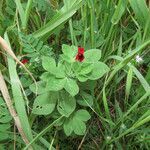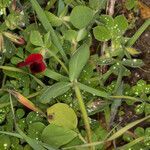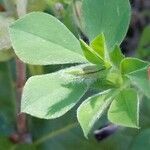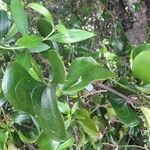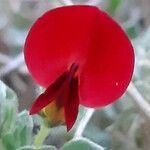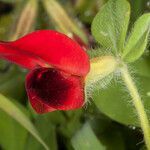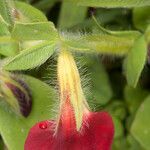Herbs, annual, 15-40 cm. Stem fleshy, prostrate, ascending, or erect, branchy, ridged, usually spreading sparsely villous. Leaflets 5, sessile, apical 3 ovate-rhombic, 2-5 × ca. 3 cm, base cuneate, apex acuminate, basal 2 stipulelike, adnate to rachis, ovate, less than 1 cm, puberulent on both surfaces. Umbels 1-or 2-flowered; peduncle short; bracts 3. Flowers 18-28 mm. Calyx ca. 15 mm, pubescent, often with dark purple spots; teeth longer than tube. Corolla scarlet, mauve when dry. Ovary glabrous; ovules numerous. Legume cylindric, (20-)30-60(-70) × 5-8 mm, tapering at both ends, margins thickened, with 4 wings by sides of both sutures, undulate, 2-4 mm in width. Seeds brown, subglobose, 3.5-4.5 mm, smooth.
More
A spreading annual plant. The leaves have 3 leaflets. Each leaflet has teeth. There are stipules or leaf like structures which are large and green. The flowers are red. The pods are square and have wings. These are wavy. The pod contains 6-9 small reddish-brown seed.
The pods are eaten when small (2.5 cm). They have an asparagus like flavour. They can be stir-fried, or added to soups and stews. The seeds are eaten like peas. They are boiled and used in soups. The roasted seeds are used in the preparation of coffee like drink.
